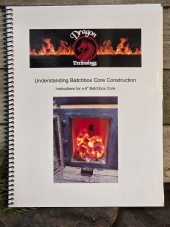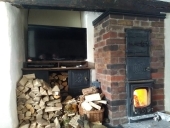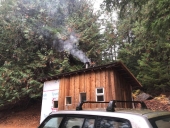A stratification chamber is more commonly known as a bell.
A bell for an RMH is nothing more than a box of a specified size with walls and a roof.
It can be any shape that fits best in the space you have.
The hottest air rises to the top and slowly sinks lower as it is replaced by hotter air (Stratifying)
At floor level, the gases locate the exit chimney and leave the bell. Ideally, exit temperatures are over 140F and below 200F having shared the majority of heat to be stored in the bell.
Tall and skinny, low as a bench, a large cube, it can have a flat top or an arched top, and it can even go under a set of stairs as long as there is easy gas (hot air) flow.
Similar to a European masonry stove, bells can also be built as a "double skin" with a brick box inside a brick box, creating twice the mass, holding the heat twice as long, and almost zero chance of exhaust gasses entering the living area.
Unlike a European design with its serpentine channels, the stratifying bell is simple to construct.
It can be made from any nonflammable material available, sheet metal, brick, stone, or even cement board or block.
They can be designed to shed heat quickly (metal) or built with mass outside or inside the enclosure to hold the heat for 24 hours or more.
They can be built as a work of art or as utilitarian as needed to keep warm.
Depending on what design RMH you build, firebricks or insulation are used for the roof of the bell, particularly over the riser.
The most important part of bell construction is to remain at or under the specified maximum ISA (internal surface area)
Peter has determined the maximum size of a bell for each size of the first generation Batchbox design.
5" BB can have an ISA of 39.8 sq ft
6" BB can have 57 sq ft
7" BB can have 77.5 sq ft
8" BB can have 101 sq ft of internal surface area
If you build the bell to match the BB size and have a proper chimney then you should have no problems with a poor draft.
Note) those numbers are for the original first generation of Batcbboxes, Shorty core uses a reduced ISA and I do not know the numbers for the DRS shoebox variants.
Surface area is simply width x height, each wall is measured, and if uninsulated the roof is measured, the floor does not count, nor does the BB core if inside the bell.
Those numbers are converted to sq ft and added together to determine the total bell ISA.
BYPASS)
A bypass is a shortcut to vent hot air from the top of the bell into the chimney, creating a strong draft.
Commonly a 4" pipe with a blast gate is used to control flow.
A proper size bell mated to the matching BB core size, with a proper chimney should not need a bypass.
A bypass will allow you to use a larger ISA than the published numbers. (But is not recommended by Peter)
A bypass can be a wonderful tool, to ease cold startups even with a proper size bell.
A bypass can be confusing to a novice stove operator, often, by leaving them open for an entire burn.
Integrating a BB core to a bell)
The most time-consuming and confusing part of a bell build is mating the core into the face of the bell.
Each build is different.
A core can be at floor level but is more commonly raised on a metal stand or sitting on a brick plinth.
Offset angle brackets and all-thread rods (tension frame) can be used to secure the core to the door backing plate or the door airframe.
Superwool insulation is used around your core to protect the metal tension frame pieces from warping.
Tapcon bolts can also be used to further secure the backing plate.
A door is hinged off of the backing plate or the airframe.
The majority of this information comes from Peter Berg's website
https://batchrocket.eu/en/building


 22
22




 5
5








 8
8




 2
2




 7
7




 3
3








 8
8











